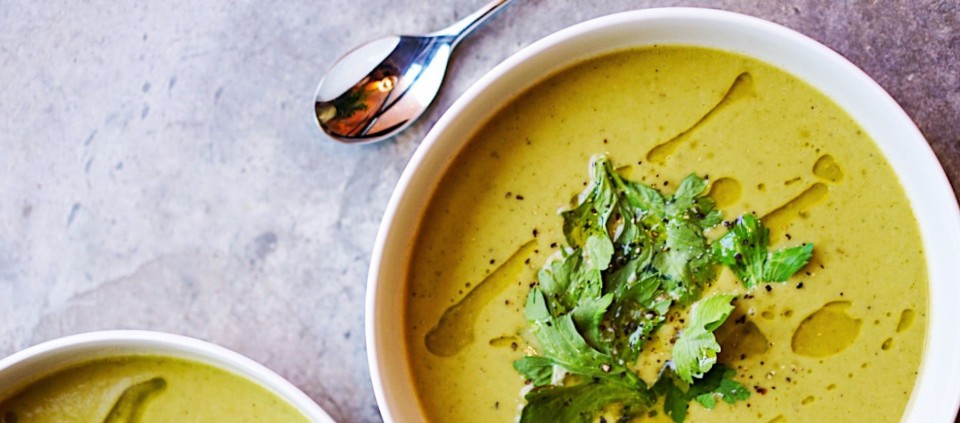How to Eat in Spring, According to Ayurveda

We live in a time in which we have access to a global market, with foods imported from the far reaches of the planet. But does that mean we should eat blueberries from Costa Rica in February in New England, where blueberries haven’t been growing for eight months? Bananas, in a country that doesn’t harvest a single banana? Salad greens in Maine in January, when the only thing growing on the ground is snow? Ayurveda would say no.
Ayurveda advises local, seasonal eating—and not because that’s the sexy new diet. Hundreds of years ago, you ate what was in season because that’s all there was. There wasn’t an option to live in Minnesota and go to the Whole Foods for avocados and jackfruit.
Eating for the Kapha Time of Year
Spring is the kapha time of year, which means that the earth and water elements are taking over (otherwise known as mud season). I live on a dirt road that is now a mud road. Even the spring snow is heavy and wet, not light and fluffy like it was back in the subzero temps of early January. Here in the Berkshires, we are in what Ayurveda would call late winter/early spring. (You may be in full-on vernal bliss as you read this, depending on where you live.)
As the temperature shifts, you might begin to feel some shifts in your body: a desire for more exercise and time outside, and a craving for lighter meals rather than the dense soups, stews, and casseroles that nourish us in fall and winter. Now’s the time to replace heavy, oily, sour, and sweet foods with foods that are pungent, bitter, astringent, dry, and light.
Eating seasonally is likely the most intuitive diet you can practice. Start with foraging at local farmers markets or joining a Community Supported Agriculture (CSA) farm. At the grocery store, look for what’s on sale in the produce section—if you see pyramids of a particular fruit or vegetable, it’s likely in seasonal abundance.
Eat Lean, Eat Green
Every year, I get so excited when my town’s farmers market starts up in late spring. Ready to load up with the bountiful spring harvest, I go to the first week’s market and come home with a skimpy bagful of radishes, ramps (wild onion), and, if I’m lucky, asparagus. Spring is lean up here in the Berkshires. My body is so ready for bitter alkaline foods by this point, and there isn’t much here.
From an Ayurvedic point of view, this is just fine. Spring is the time of year to eat lean. All winter, I have been crushing pasta, stews, meats, and cheese. It’s time to reset the digestion and cleanse out the weight of the winter. In fact, spring and summer are the best seasons for eating vegetarian or vegan.
Go Light
Here are some ways to lighten up your diet this spring.
- Favor vegetables and small legumes, like red lentils and mung beans.
- Lay off meat, wheat, dairy, and sugar, which are all difficult to digest.
- When choosing grains, swap out heavy wheat and oatmeal for lighter options like millet, quinoa, and barley.
- Add lots of spices to your dishes, including black pepper, turmeric, ginger, garlic, cumin, and mustard seeds.
- Get outside and forage for fiddleheads, ramps, dandelions, and nettles. Be sure to consult a foraging guide.
- Eat green! Green everything. Your plate should be just as green as the fluorescent-green spring landscape.
Clean Green Soup
Use whatever proportion and variety of green vegetables you prefer.
2 cups water
4 cups fresh broccoli crowns and stalks, chopped in 1-inch pieces
2 stalks fresh celery, chopped in 1-inch pieces
4 cups fresh spinach or other greens
2 cups water or homemade vegetable stock
½ teaspoon black pepper
1 teaspoon ground turmeric
Salt to taste
Fresh lemon
In a medium saucepan, combine water, vegetables, black pepper, and turmeric, and bring to a boil. Turn heat down to medium and cook for 10 minutes, or until the vegetables are soft, but not too soft. Take pan off heat and blend mixture till smooth, using an immersion blender; you might need to add more hot water to achieve a thick but not gloppy consistency. Add salt to taste. Top with a fresh squeeze of lemon.
Find out about upcoming Ayurveda programs with Erin Casperson at Kripalu.
© Kripalu Center for Yoga & Health. All rights reserved. To request permission to reprint, please email editor@kripalu.org.
Erin Casperson, Lead Kripalu Faculty and Director of the Kripalu School of Ayurveda, is passionate about sharing how the ancient practices of Ayurveda can be applied to modern-day living.
Full Bio and Programs